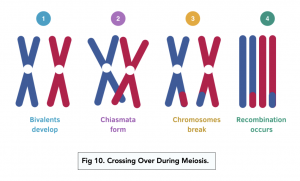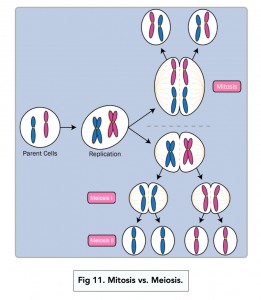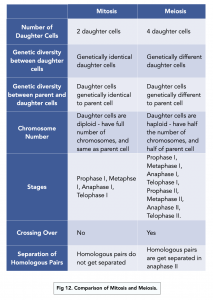How Meiosis Produces Variation (A-level Biology)
How Meiosis Produces Variation
Sources of Genetic Diversity
There are two key sources of genetic diversity in meiosis: crossing over and independent assortment.
Crossing Over
We mentioned crossing over when discussing meiosis I. In crossing over, two homologous chromosomes come together and align, and then recombine and swap parts with each other.
- Bivalents develop. Homologous chromosomes come together to form bivalents.
- Chiasmata form. Non-sister chromatids wrap around each other, and they join up at certain points (called chiasmata)
- Chromosomes break. The chromosomes can break up at the chiasmata, and sections of chromosomes may swap over between non-sister chromatids. The swapping over is only between non-sister chromatids.
- Recombination occurs. The final chromatids still have the same genes, but they may have different alleles.
Overall, crossing over results in the creation of new alleles and ensures that offspring are not genetically identical to their parents.

Independent Assortment
In meiosis II, each pair of homologous chromosomes is split up. Remember, in any cell the homologous pair consists of two chromosomes which may or may not be identical. When the pair splits up, each daughter cell will receive one chromosome. The allocation of this is completely random – hence we call it independent assortment.
In terms of a textbook definition, independent assortment means that each chromosome is inherited randomly and independent of other chromosomes – i.e. the inheritance of one chromosome does not affect the inheritance of another chromosome.
From both independent assortment and crossing over, it is clear to see that the role of meiosis is to ensure genetic variation. Meiosis produces non-identical gametes through recombination of alleles.
Measuring Genetic Diversity
Genetic diversity resulting from meiosis can be measured:
n = number of homologous pairs
- Due to the splitting in meiosis, the possible number of combinations of chromosomes in gametes is 2n.
- Due to independent assortment, each chromosome can undergo a further randomisation and pairing. Therefore, the overall number of possible chromosome combinations in a single gametic cell is (2n)2, where n is the total number of pairs of homologous chromosomes in an organism.
For example:
- Humans have 23 pairs of chromosomes, hence n = 23.
- 2n = 46
- (2n)2 = 2,116
- This means that there are 2,116 different possible combinations of chromosomes which can be inherited by a single offspring.
Mitosis vs. Meiosis


Meiosis is a type of cell division that produces gametes, or sex cells, that are used in sexual reproduction. This process reduces the chromosome number by half, leading to the production of haploid cells with half the number of chromosomes as the original cells.
Meiosis is important for producing variation because it shuffles the genetic material in a way that leads to the formation of new combinations of alleles, or different versions of genes. This variation contributes to the diversity of traits found in a population and is an important mechanism for the evolution of species.
Meiosis leads to the production of new combinations of alleles through the process of genetic recombination. This occurs when homologous chromosomes, or chromosomes that carry the same genes, pair up and exchange segments of DNA during the first meiotic division. The result is the production of daughter cells with a unique combination of alleles.
Mitosis and meiosis are both types of cell division, but they differ in several important ways. Mitosis is the type of cell division that produces identical daughter cells with the same number of chromosomes as the parent cell. In contrast, meiosis reduces the chromosome number by half and produces daughter cells with unique combinations of alleles.
Meiosis is divided into two main stages: meiosis I and meiosis II. Meiosis I is characterized by the separation of homologous chromosomes, while meiosis II is characterized by the separation of sister chromatids, or identical copies of a chromosome. The result is the production of four genetically distinct daughter cells.
Meiosis contributes to evolution by producing genetic variation that can be selected by natural selection. This variation allows species to adapt to changing environments and helps to drive the process of evolution over time.
If meiosis goes wrong, it can lead to a variety of genetic disorders, including Down syndrome, Turner syndrome, and Klinefelter syndrome. These disorders are caused by the presence of an extra or missing chromosome, which can result from errors during meiosis.
Yes, meiosis can be studied in the laboratory using techniques such as genetic crosses, microscopy, and molecular biology. These techniques allow researchers to study the molecular mechanisms of meiosis and to understand how it contributes to genetic variation and evolution.






Still got a question? Leave a comment
Leave a comment